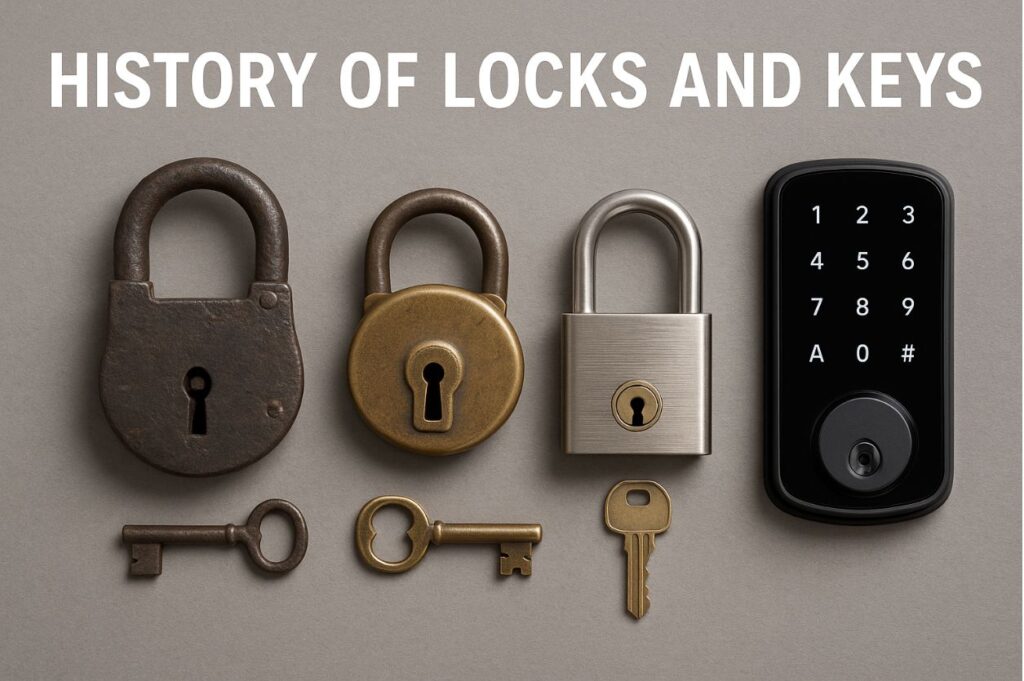For centuries, locks and keys have been vital to human civilization, protecting homes, valuables, and personal belongings. How did we evolve from the basic wooden locks of ancient Egypt to the advanced security systems we use today? The history of keys and locks is a captivating journey that spans thousands of years. In this blog, we will explore the evolution of locks, from their early beginnings to the modern technologies that are shaping the locksmithing industry today.
| Period | Key Milestones | Key Innovations |
| Ancient Egypt (2000 BC) | Introduction of the pin tumbler lock. | The earliest known form of lock, made of wood, required a pin tumbler key to open. |
| Ancient Rome (300 BC) | Use of iron locks and keyhole technology. | Roman locks were more durable, incorporating iron and the first keyhole designs. |
| Middle Ages (5th-15th Century) | Introduction of combination locks and larger, more intricate locks for castles and monasteries. | Locks became more complex with a focus on security for homes, gates, and castles. |
| 18th Century (Industrial Revolution) | Mass production of metal locks, including the pin tumbler mechanism. | The introduction of metalworking allowed for stronger, more secure locks. |
| 19th Century | Invention of the modern pin tumbler lock (still widely used today). | This mechanism became the standard for locks, allowing higher security and mass production. |
| 20th Century | Introduction of combination locks and electronic locks. | Combination locks were used in safes, and electronic locks emerged for commercial use. |
| 21st Century (Modern Day) | Emergence of smart locks and AI-powered security systems. | Smart locks that can be controlled by smartphones and AI-integrated systems enhance security and user experience. |
From simple mechanisms designed to prevent unauthorized access to sophisticated digital security solutions, locks and keys have continuously evolved to meet the growing demand for safety and privacy. Along the way, advancements in materials, mechanics, and even artificial intelligence (AI) have revolutionized the security industry. Let’s dive into the history of locks and keys and explore their fascinating journey.
Early Beginnings: Ancient Locks and Keys
The first recorded use of locks dates back over 6,000 years, in ancient Mesopotamia (modern-day Iraq). Early locks were made from wood, and their mechanisms were quite simple compared to what we have today. For a deeper understanding of different types of locks, check out our guide on types of cupboard locks.
Image Source
The Egyptian Lock (2000 BC)
One of the earliest forms of locking mechanisms comes from ancient Egypt. Ancient Egyptians designed the earliest working lock, using a pin tumbler mechanism to secure doors and possessions. These locks were made from wood and used a simple mechanism where a set of pins prevented the lock from opening unless a corresponding key was inserted. This early lock-and-key design laid the groundwork for the modern locking systems we rely on today.
The Roman Era: Iron Locks
As the Roman Empire expanded, so did the complexity of its locks. The Romans introduced iron locks that were more durable and secure than the wooden ones used by the Egyptians. These locks often featured advanced mechanisms, including the first form of keyhole technology. These devices often included intricate mechanisms and were among the first to use a recognizable keyhole design.
| Period | Lock Type | Key Innovation |
| Ancient Mesopotamia | Wooden Locks | Simple mechanisms with wooden construction. |
| Ancient Egypt (2000 BC) | Pin Tumbler Lock | Invention of the first functional lock using a pin tumbler system. |
| Roman Era | Iron Locks | Introduction of iron locks, more durable than wooden versions. Advanced keyhole technology. |
The Middle Ages: Advancements in Lock Technology
During the Middle Ages, lock technology continued to improve, with more intricate designs and materials being used. These locks were often larger and more complex, designed to provide stronger security for castles, monasteries, and important documents.
The Development of the Key and Lock System
While earlier locks were primarily used in large buildings and fortresses, the key and lock system began to spread to homes and smaller properties. By the 14th century, advancements in metalworking enabled the creation of locks with more refined mechanisms, tailored to individual keys. Blacksmiths began to create more durable locks with intricate mechanisms that required specially designed keys to open them.
Some of the earliest designs featured combination locks, where the user would have to align certain mechanisms to open the lock. The development of these more sophisticated locks made it more difficult for thieves to break into secured areas.
Early Padlocks
During this time, padlocks became increasingly prevalent. Padlocks, which were portable and could be used on gates, chests, and doors, became an essential tool for personal security. These devices typically included a locking bar that could be released by the right key, offering practical and effective protection.
The Industrial Revolution: Key Innovations in Lockmaking
The 18th and 19th centuries’ Industrial Revolution brought major advancements in the design and production of locks and keys. As industrial production expanded, locks could be made more efficiently and with greater accuracy.
The Pin Tumbler Lock
The 19th century saw the invention of the pin tumbler lock, which remains one of the most widely used locking mechanisms today. This lock works by using a series of pins that are set at different heights inside a cylindrical lock. Inserting the correct key aligns the pins precisely, allowing the lock to disengage and open. This design dramatically improved lock security and became a foundation for future locking systems.
The Rise of Locksmithing
As lock technology advanced, the role of the locksmith became more prominent. With the increasing demand for locks, locksmiths began to specialize in creating, repairing, and installing these devices. Over time, guilds and organizations were established to uphold the standards and practices within the locksmithing trade
The 20th Century: The Age of Modern Security
In the 20th century, advanced lock technologies became widely adopted across various industries. With the advent of mass production and the increasing complexity of security needs, locks became more sophisticated, offering a higher level of security for both homes and businesses. The century also witnessed the growing need for locksmiths to verify client ownership properly, a practice that remains critical today, as explained in how locksmiths verify ownership.
The Introduction of Combination Locks
Combination locks, which are operated by dialing a series of numbers or letters, became popular during this time. These locks found application in safes, lockers, and other areas requiring high security. Unlike traditional locks requiring keys, these relied on a memorized code, reducing the risk of losing access.
The Development of Electronic Locks
In the mid-20th century, the development of electronic locks marked a new era in lock technology. These locks use electronic components such as sensors, keypads, or biometric scanners to authenticate users. Electronic locks provide enhanced capabilities like remote access, time-sensitive control, and seamless integration with security systems, making them perfect for both commercial and residential applications.
The Role of AI in Modern Lock and Key Technology
As technology continues to evolve, artificial intelligence (AI) has started to play a significant role in the development of modern lock and key systems. AI enhances security by improving lock reliability, ease of use, and overall functionality. Modern AI systems also support locksmiths who work with vehicles, enabling them to reprogram key fobs and program transponder keys efficiently for enhanced automotive security.
Smart Locks and AI Integration
One of the most exciting innovations in the locksmithing industry is the development of smart locks, which combine traditional locking mechanisms with cutting-edge technology. By learning user patterns and detecting anomalies, AI-integrated smart locks can automatically respond to potential threats in real time.
AI-powered smart locks use machine learning algorithms to detect unusual activity, such as attempts to bypass the lock or unauthorized access. These systems can send real-time alerts to the user, enhancing the overall security of homes and businesses.
AI in Key Duplication and Security Systems
AI has also transformed the way keys are duplicated. With AI-powered machines, locksmiths can now duplicate keys more accurately and efficiently, reducing the risk of errors. Additionally, AI is being used to develop advanced security systems that can analyze patterns of behavior and adapt to changing security needs.
Conclusion: The Enduring Legacy of Locks and Keys
The history of locks and keys is a testament to humanity’s ongoing pursuit of safety and security. From the simple wooden locks of ancient Egypt to the AI-powered smart locks of today, locks have continuously evolved to meet the changing demands of society. Locks will continue to improve as technology advances, and locks will become more secure, reliable, and convenient.
Whether you’re looking for traditional locks, modern smart locks, or cutting-edge security systems, understanding the history of locks and keys can provide valuable insight into the future of security. With AI at the forefront of innovation, the next chapter in the history of locks and keys promises even greater advancements in the world of personal and commercial security.








